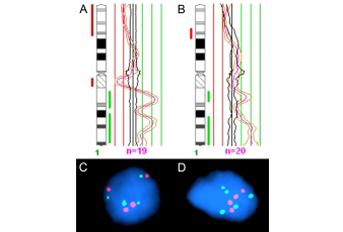Associação Portuguesa de Investigação em Cancro
Copy number and expression changes of the ETV3 and ELF3 genes in breast cancer
Copy number and expression changes of the ETV3 and ELF3 genes in breast cancer

Os factores de transcrição ETS estão envolvidos na carcinogénese via diferentes mecanismos. O ganho/amplificação de número de cópias génicas é um dos mecanismos de activação oncogénica. No cancro da mama, o ganho de 1q é a alteração de número de cópias mais comum. Assim, perguntámos qual seria o impacto de alterações genómicas na expressão de três genes membros da família dos ETS (ELF3, ETV3 e ELK4), cujos loci estão em 1q. Avaliámos por hibridação genómica comparativa (CGH) 141 carcinomas da mama e demonstrámos que as bandas cromossómicas 1q21 e 1q32 apresentavam a frequência mais elevada de ganhos de cópias cromossómicas. De seguida, confirmámos por FISH com sondas locus-específicas obtidas por clones de BACs que nos casos que apresentavam ganhos/amplificações de 1q por CGH também se verificava o aumento de número de cópias do ETV3 (loci 1q21~23), ELF3 e ELK4 (ambos localizados em 1q32). Avaliámos os níveis de expressão génica por PCR quantitativo em tempo real destes três genes, bem como potenciais genes alvo destes factores de transcrição, nomeadamente os genes MYC e CRISP3. Assim, neste trabalho reportámos pela primeira vez que os ganhos de cópias genómicos mais comuns no cancro da mama, 1q21 e 1q32, estão associados com a sobre-expressão dos factores de transcrição ETV3 e ELF3 (o mesmo não se verificando para o ELK4), independentemente do subtipo molecular. De entre os três genes ETS localizados em 1q, o ELF3 tem um papel relevante na carcinogénese mamária e é o alvo mais provável do aumento de número de cópias de 1q. O subtipo molecular do tipo basal apresentou o pior prognóstico analisando a sobrevivência específica de doença, mas não se verificou valor de prognóstico adicional da alteração do número de cópias de 1q ou da expressão de ELF3. Adicionalmente, demonstrou-se que existe uma correlação entre a expressão do oncogene MYC, independentemente do ganho do número de cópias no locus 8q24, e a expressão do repressor transcripcional ETV3 e do androgénio-dependente ELK4.
Bárbara Mesquita(1,4), Paula Lopes(2), Ana Rodrigues(3), Deolinda Pereira(3), Mariana Afonso(2), Conceição Leal(2), Rui Henrique(2,5,6), Guro E. Lind(7,8), Carmen Jerónimo(1,5,6), Ragnhild A. Lothe(7,8), Manuel R. Teixeira(1,4,6,8) 1- Department of Genetics, Portuguese Oncology Institute, Porto, Portugal 2- Department of Pathology, Portuguese Oncology Institute, Porto, Portugal 3- Department of Medical Oncology, Portuguese Oncology Institute, Porto, Portugal 4- Cancer Genetics Group, Research Centre of the Portuguese Oncology Institute, Porto, Portugal 5- Cancer Epigenetics Group, Research Centre of the Portuguese Oncology Institute, Porto, Portugal 6- Department of Pathology and Molecular Immunology, Institute of Biomedical Sciences Abel Salazar (ICBAS), University of Porto, Porto, Portugal 7- Department of Cancer Prevention, Institute for Cancer Research, Norwegian Radium Hospital, Oslo University Hospital, Oslo, Norway 8- Centre for Cancer Biomedicine, Faculty of Medicine, University of Oslo, Oslo, Norway
FREQUENT COPY NUMBER GAINS AT 1q21 AND 1q32 ARE ASSOCIATED WITH OVEREXPRESSION OF THE ETS TRANSCRIPTION FACTORS ETV3 AND ELF3 IN BREAST CANCER IRRESPECTIVE OF MOLECULAR SUBTYPES. Several ETS transcription factors are involved in the pathogenesis of human cancers by different mechanisms. As gene copy number gain/amplification is an alternative mechanism of oncogenic activation and 1q gain is the most common copy number change in breast carcinoma, we investigated how that genomic change impacts in the expression of the three 1q ETS family members ETV3, ELK4 and ELF3. We have first evaluated 141 breast carcinomas for genome-wide copy number changes by chromosomal CGH and showed that 1q21 and 1q32 were the two chromosome bands with most frequent genomic copy number gains. Second, we confirmed by FISH with locus-specific BAC clones that cases showing 1q gain/amplification by CGH showed copy number increase of the ETS genes ETV3 (located in 1q21~23), ELF3 and ELK4 (both in 1q32). Third, gene expression levels of the three 1q ETS genes, as well as their potential targets MYC and CRISP3, were evaluated by quantitative real-time PCR. We here show for the first time that the most common genomic copy number gains in breast cancer, 1q21 and 1q32, are associated with overexpression of the ETS transcription factors ETV3 and ELF3 (but not ELK4) at these loci irrespective of molecular subtypes. Among the three 1q ETS genes, ELF3 has a relevant role in breast carcinogenesis and is also the most likely target of the 1q copy number increase. The basal-like molecular subtype presented the worst prognosis regarding disease-specific survival, but no additional prognostic value was found for 1q copy number status or ELF3 expression. Additionally, we show that there is a correlation between the expression of the oncogene MYC, irrespectively of copy number gain at its loci in 8q24, and the expression of both the transcriptional repressor ETV3 and the androgen respondent ELK4.
Breast Cancer Res Treat (2013) 138:37-45
http://link.springer.com/article/10.1007%2Fs10549-013-2408-2




